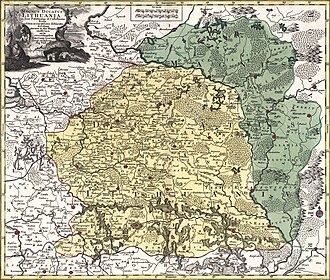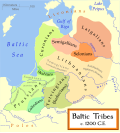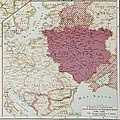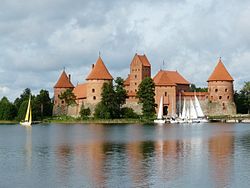Grand Duchy of Lithuania
The Grand Duchy of Lithuania was a European state from the 12th[1] –13th century until 1569. In 1569 it became a part of the Polish–Lithuanian Commonwealth until 1791. It was started by the Lithuanians.[2][3][4] The duchy grew to include large parts of the former Kievan Rus' and other Slavic lands. It covered the land of present-day Belarus, Latvia, Lithuania and parts of Estonia, Moldova, Poland, Russia and Ukraine. At its biggest in the 15th century, it was the largest state in Europe.[5] There was great diversity in languages, religion, and cultural heritage.
Grand Duchy of Lithuania | |||||||||||||
|---|---|---|---|---|---|---|---|---|---|---|---|---|---|
| 1240–1795 | |||||||||||||
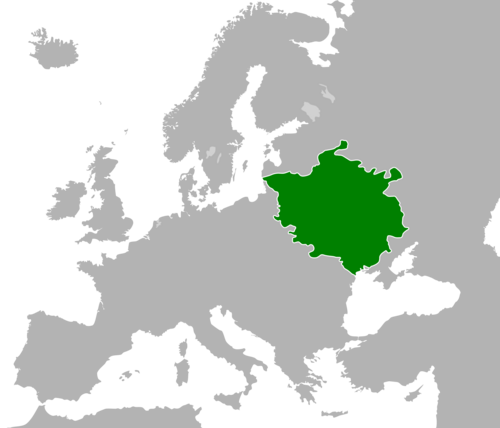 Grand Duchy of Lithuania in 1430 | |||||||||||||
| Capital | Novogrudok (c. 1230-1270) Kernavė (1270-1321) | ||||||||||||
| Demonym(s) | Lithuanian | ||||||||||||
| Government | |||||||||||||
• first Grand duke of Lithuania | Mindaugas | ||||||||||||
• last Grand duke of Lithuania | Stanisław August Poniatowski | ||||||||||||
| Establishment | Establishment | ||||||||||||
• Unification of Lithuanian duchies | 1240 | ||||||||||||
| 1795 | |||||||||||||
| ISO 3166 code | LT | ||||||||||||
| |||||||||||||
Bringing together of the Lithuanian lands began in the late 12th century. Mindaugas, the first ruler of the Grand Duchy, was crowned as Catholic King of Lithuania in 1253. The pagan state was targeted in the religious crusade by the Teutonic Knights and the Livonian Order. When Gediminas began to rule, he allowed people to have different religions.[6] This grew under his son Algirdas.[7] In 1386 Jogaila changed the religion to Catholicism. He also made a dynastic union between the Grand Duchy of Lithuania and the Kingdom of Poland.[8]
Vytautas the Great grew the land of the Grand Duchy. He also led the defeat of the Teutonic Knights in the Battle of Grunwald in 1410. After Vytautas's death, Lithuania's relationship with the Kingdom of Poland was not good.[9] The Union of Lublin of 1569 created a new state, the Polish–Lithuanian Commonwealth. In this federation, the Grand Duchy of Lithuania had a separate government, laws, army, and treasury. [10] They were invaded by Russia in 1792. The land was divided out among the Russian Empire, Prussia and Austria in 1795.
Grand Duchy Of Lithuania Media
Lithuania in the Mappa mundi of Pietro Vesconte, 1321. The inscription reads: Letvini pagani – pagan Lithuanians.
Balts in the 12th century
Gediminas' Tower in Vilnius
Lubart's Castle in Ukraine, built by the son of Gediminas' Liubartas in the mid-14th century, is famous for the Congress of Lutsk which took place in 1429
Poland and Lithuania in 1386–1434
Trakai Island Castle, residence of the Grand Duke Vytautas
The Battle of Grunwald, 1410, with Ulrich von Jungingen and Vytautas at center
References
| Wikimedia Commons has media related to Lua error in Module:Commons_link at line 62: attempt to index field 'wikibase' (a nil value).. |
- ↑ T. Baranauskas. Lietuvos valstybės ištakos. Vilnius, 2000
- ↑ Rowell S.C. Lithuania Ascending: A pagan empire within east-central Europe, 1295-1345. Cambridge, 1994. p.289-290
- ↑ Ch. Allmand, The New Cambridge Medieval History. Cambridge, 1998, p. 731.
- ↑ Encyclopædia Britannica. Grand Duchy of Lithuania
- ↑ R. Bideleux. A History of Eastern Europe: Crisis and Change. Routledge, 1998. p. 122
- ↑ Rowell, Lithuania Ascending, p.289.
- ↑ Z. Kiaupa. "Algirdas ir LDK rytų politika." Gimtoji istorija 2: Nuo 7 iki 12 klasės (Lietuvos istorijos vadovėlis). CD. (2003). Elektroninės leidybos namai: Vilnius.
- ↑ N. Davies. Europe: A History. Oxford, 1996, p. 392.
- ↑ J. Kiaupienė. Gediminaičiai ir Jogailaičiai prie Vytauto palikimo. Gimtoji istorija 2: Nuo 7 iki 12 klasės (Lietuvos istorijos vadovėlis). CD. (2003) Elektroninės leidybos namai: Vilnius.
- ↑ D. Stone. The Polish-Lithuanian state: 1386-1795. University of Washington Press, 2001, p. 63.

